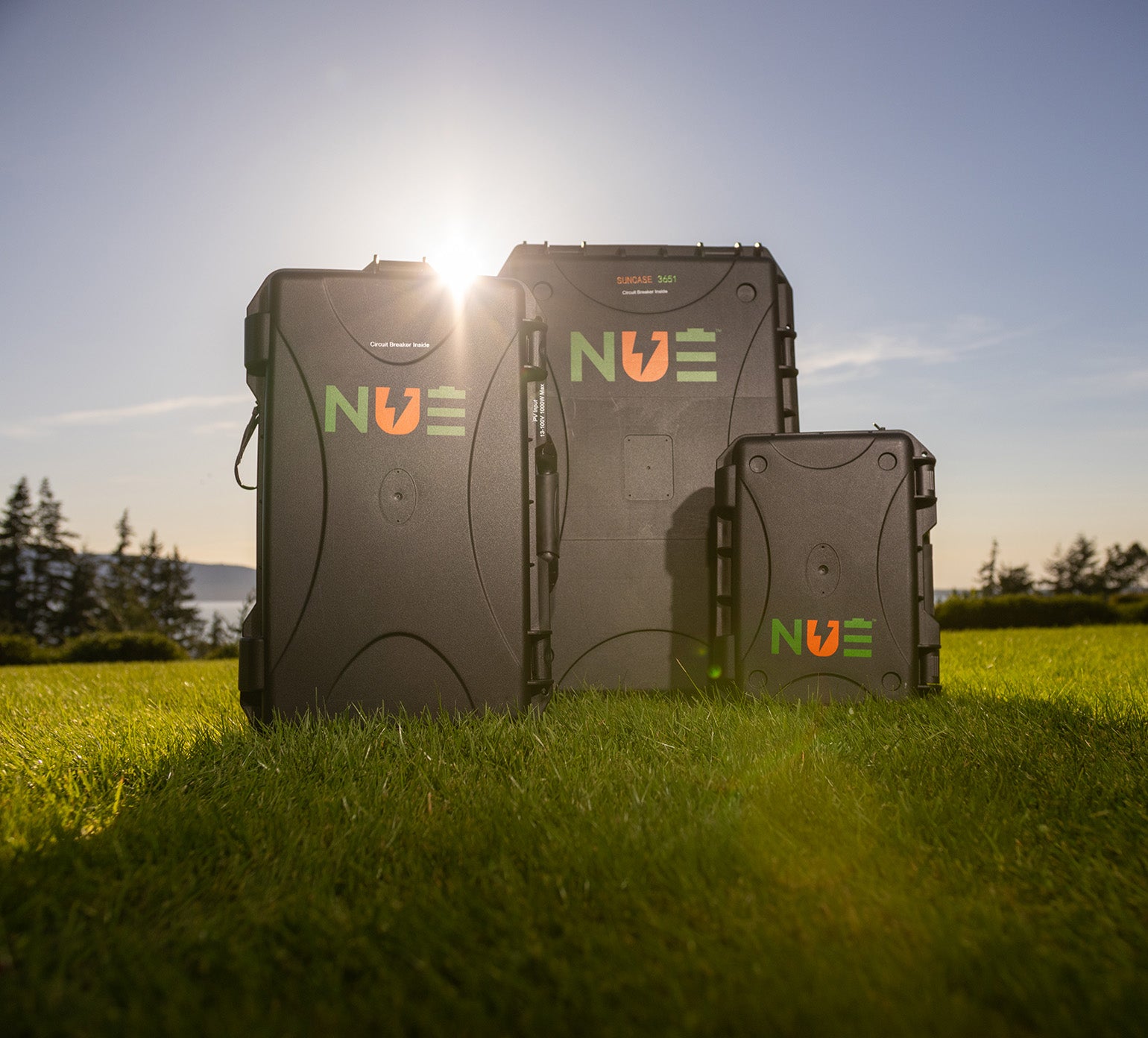
Lithium-ion vs. Lead-acid Batteries: What’s the Difference?
Whether you are new to using solar energy or have been for years, you may be debating between lithium-ion vs. lead-acid batteries. These two batteries are the most common rechargeable options paired with solar installations. In recent years, lithium-ion batteries have increasingly come to replace the older option of lead-acid. Why is that the case? This is because wherever lead-acid is used, lithium-ion can be implemented and has superior performance characteristics.

A solar-powered trailer with lithium-ion battery storage by New Use Energy (NUE)
5 Key Elements to Consider
1. Capacity
A battery’s capacity is characterized as a measure of energy that can be stored within a battery. Considering various makes and models, lithium-ion batteries consistently prove to have a significantly higher energy density than lead-acid batteries. Thus, the lithium-ion option stores more energy, allowing you to utilize a greater amount. In comparison, lead-acid batteries store less energy for the same amount of physical space as lithium-ion batteries. When considering capacity, we should also analyze how long it will take a system to discharge. We recognize the fact that a shorter discharge signifies a lower capacity available within a lead-acid system. Comparing capacity and discharge rate of same-sized systems, a lithium-ion option will discharge at a much faster rate and use more of the battery’s capacity (85 percent compared to 50 percent for lead-acid). In some instances, comparing systems may require conversions between Amp-Hours (Ah) and Kilowatt-Hours (kWh).
2. Depth of discharge
Depth of discharge (DoD) is the percentage of a battery that may be safely drained of energy without causing significant damage to the battery. In the case of lithium-ion batteries, it is normal and safe to use 85% or higher of total capacity in a single cycle. However, lead-acid batteries should not be discharged past 50%. This will cause significant degradation and affect the battery’s lifetime. Ultimately, lithium-ion batteries have a greater effective capacity, meaning you can use these batteries for longer times. Likewise, Lithium-ion batteries supply a consistent amount of power throughout a discharge cycle. Comparatively, lead-acid batteries deliver a strong output of energy at the beginning of a discharge cycle and later dissipate.
3. Efficiency

Efficiency reads as the amount of stored energy within the battery that may be utilized. Lithium-ion batteries can be around 95% efficient or sometimes even greater. With such a high percentage of efficiency, lithium-ion options can ultimately charge faster and possess a greater effective battery capacity. In comparison, lead-acid options are only about 80 to 85% efficient. Additionally, lead-acid systems have longer charge times that may range anywhere from two to four hours depending on the depth of discharge. As a result, charge efficiency will become low during extreme weather conditions, resulting in reduced battery life. By comparison, lithium-ion batteries may charge in one to two hours and can absorb energy at higher rates.
4. Cost
Pricing for lithium-ion vs. lead-acid batteries generally depends on a system’s size. However, it can be said that lead-acid batteries are often cheaper compared to lithium-ion. Lead-acid batteries range in price from hundreds to thousands. Comparatively, industrial size units of lithium-ion batteries currently cost anywhere from $700 to $2,500. Initially, the lead-acid option may seem more logical due to price. Lithium-ion batteries have an upfront investment but excel in the areas we’ve already mentioned. Because lithium-ion batteries sustain more cycles in their lifetime, each cycle would cost less than that of lead-acid batteries. Overall, a lithium-ion battery would cost less in the long run compared to lead-acid.
5. Lifespan
Similar to any manufactured product, batteries degrade and become less effective with age. Although lifespan may vary by make and model, lithium-ion batteries generally last much longer than lead-acid batteries. Many lithium-ion batteries will last over 5000 cycles, whereas lead-acid will support 1/10 the cycles (500 at the most). Even in more extreme climates with high temperatures, lithium-ion options continue to outperform lead-acid options. Overall, lead-acid batteries are much more sensitive to increasing temperature and other fluctuations in the environment.
Lithium-ion vs. Lead-acid: What Suits You Best?
When considering which battery option best suits you, there are two factors to consider: climate and usage frequency.
Climate
In warmer climates, lithium-ion batteries are better suited. They can operate at higher temperatures (131°F/55°C for example) at twice the lifecycle of a lead-acid battery at room temperature. Furthermore, lead-acid batteries begin to significantly degrade at around 77°F/25°C and higher. So, they become more difficult to manage in warmer settings.
In cold weather operations, both types of batteries are likely to lose. However, lithium-ion applications lose significantly less capacity when temperatures drop to the -4°F/-20°C range than lead-acid batteries. Additionally, lithium-ion should not be charged below 0°C as this is likely to damage the battery.
Usage Frequency
In instances where you use energy more frequently, such as powering daily appliances and industrial sites with heavy energy usage, lithium-ion batteries are a better option. Furthermore, lithium-ion’s lighter weight (55% lighter than lead-acid) makes them more suitable for mobile installation situations. Off-grid solar systems are another operation that pairs greatly with lithium-ion batteries. They can provide an independent power supply for various applications such as backup power, appliances, cooling/heating or computer use.
On the other hand, lead-acid batteries would prove to be a better option for lower temperature situations. For these instances, lithium-ion batteries are unable to charge in temperatures below 32°F/0°C. Lithium-ion batteries rely on ionic chemical reactions to create energy where lower temperatures would prevent these reactions from occurring.
Environmental Impacts

Lead-acid batteries ready for disposal
Although both battery options are not completely free of environmental impacts, lithium-ion batteries prove to be better vs. lead-acid. Despite lithium mining being a resource-extensive practice, this element is only a small portion of the battery cell by mass. By comparison, aluminum and cobalt environmental impacts can be more significant than that of lithium. Granting that recycling continues to be in the early stages of preparation, nickel, cobalt, and copper have shown a high ability of recovery and recyclability. Lead mining uses a greater amount of raw materials to achieve energy storage. As a result, this process generates a much larger impact on the environment during mining processes. These impacts include the disposal of large quantities of cadmium and lead into the environment and the production of gaseous emissions. The energy-intensive industry of lead mining causes large amounts of pollution.
























